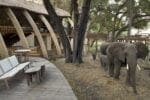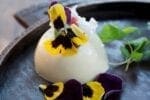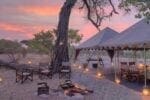A birding safari in Botswana (an excellent birding destination) is very popular. Especially as they have over 550 recorded species of birds. The habitat ranges from wet delta to desert bush; where both water birds and dry-country species can be seen.
When is the best time for a birding safari?
A birding safari in Botswana’s warm and wet summer months is a wonderful affair. Colorful plumage and raucous mating calls bring a special energy to the skies over the country’s premier wilderness areas. The sandy riverbanks and surrounding vegetation become a festival of migratory and resident bird species; both aquatic and terrestrial; that come to breed and raise their young in this natural paradise.
While the dry winter season might be the time for excellent animal sightings; November to April is the period best-suited for avid birders. Pack your binoculars, cameras, and bird books (or apps) for a birding safari in Botswana.
Birding season starts in September; when the first migrants arrive; boosting the bird population by up to 20% compared to the winter months. In April/May, the migratory birds begin their flights to winter-feeding and breeding grounds in faraway places.
Where to go?
Chobe National Park and the Okavango Delta (including Moremi), where permanent water is around offer the best birding in Botswana. Makgadikgadi Pans is also a great park for bird watching throughout the year. But the wet summer months are the real highlight. Especially if the pans fill up and flocks of lesser and greater flamingo; accompanied by pelican; come feeding in the shallows. The timing depends on the rain and algae levels and is highly variable. But the best months are in the wet season, from November to April. The Kgalagadi Transfrontier National Park is also an excellent birders paradise with over 170 species of birds. All of this makes Botswana one of the best places for a birding safari in Southern Africa.
One of the most thrilling ways to get up close to waterbird species is by boat or mekoro. Along the Chobe River or the channels of the Okavango Delta. Where you can see the African Jacana or ‘Jesus Bird’; slaty Egret and Southern Carmine Bee-eaters. People often remark that many of the birds on the riverbanks are generally unconcerned by the passing boat. Which makes for fantastic photography opportunities.
While on a birding safari; it will be hard to miss Africa’s heaviest flying bird; the kori bustard. Along with the Marabou stork or ‘Undertaker Bird’. The marabou stork is also a ‘wading bird’ so you can also find it in wet habitats.
On your game drive, you will be able to tick off some more of those birding specials; like the Knysna turaco, or thrush nightingale. And; if you are lucky, even the elusive Pel’s fishing owl.
Waterbird breeding sites – Heronries
Every year various waterbird species gather at well-used breeding sites to nest and raise their chicks. Several known sites provide the right conditions for the birds to breed. Usually; these are in lagoons with isolated “islands” of trees or thickly matted reed beds. The birds feel safe in numbers, and different species can nest side by side. This usually happens between August and November. As temperatures heat up and the water levels drop. The biggest; and most well-known heronry site is Godikwe Lagoon. This is accessible when staying in the Moremi. Species include Yellow-billed Storks, African Open Bills, Marabou Storks, Grey Herons, African Darters. And also Pink Backed Pelicans.
The birds have become used to the boats and people so you can really get in close and watch them build their nests, ward off predators and feed their chicks. Obviously, this makes it great for photographers.

























